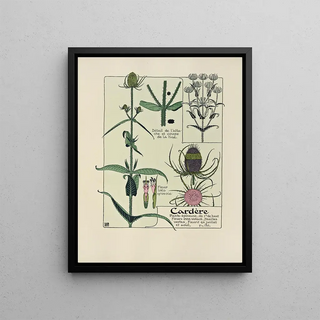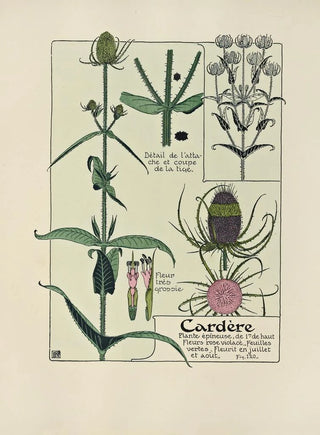Art print | Cardère - Maurice Pillard Verneuil


View from behind

Frame (optional)
Cardère Art print - Maurice Pillard Verneuil – Captivating introduction
Nature, with its shapes and colors, has always been an inexhaustible source of inspiration for artists. In this quest for harmony between man and his environment, Maurice Pillard Verneuil stands out with his unique approach. The Cardère art print - Maurice Pillard Verneuil is a perfect example of this alchemy. It evokes a floral universe where the delicacy of the cardères blends with a subtle palette, creating an atmosphere that is both soothing and enchanting. This painting, a true ode to the beauty of nature, invites the viewer to immerse themselves in a world where every detail matters, where every shade of color tells a story.
Style and uniqueness of the work
Verneuil's work is characterized by impressive technique and a keen sense of aesthetics. In this piece, the cardères, with their elongated stems and delicate flowers, are depicted with a precision that borders on perfection. The colors, ranging from deep greens to subtle violets, intertwine harmoniously, creating a captivating visual dynamic. The light, omnipresent, seems to play on the surfaces, revealing rich and varied textures. This choice of representation reflects a particular sensitivity to the beauty of simple things. Verneuil manages to transform an ordinary subject into a work of art with great depth, where each glance reveals new subtleties. This approach, both realistic and poetic, makes this work a true masterpiece of floral art.
The artist and his influence
Maurice Pillard Verneuil, an emblematic figure of early 20th-century decorative arts, knew how to mark his era with his unique style and artistic vision. He is part of the Art Nouveau movement, which advocates an aesthetic inspired by nature. Verneuil is not just a painter; he is also a designer and illustrator, allowing him to explore various forms of artistic expression. His influence is felt in many fields, from textile design to ceramics, where his floral motifs continue to inspire contemporary creators. Through his works, he invites contemplation of nature, a rediscovery of forms and of

Matte finish

View from behind

Frame (optional)
Cardère Art print - Maurice Pillard Verneuil – Captivating introduction
Nature, with its shapes and colors, has always been an inexhaustible source of inspiration for artists. In this quest for harmony between man and his environment, Maurice Pillard Verneuil stands out with his unique approach. The Cardère art print - Maurice Pillard Verneuil is a perfect example of this alchemy. It evokes a floral universe where the delicacy of the cardères blends with a subtle palette, creating an atmosphere that is both soothing and enchanting. This painting, a true ode to the beauty of nature, invites the viewer to immerse themselves in a world where every detail matters, where every shade of color tells a story.
Style and uniqueness of the work
Verneuil's work is characterized by impressive technique and a keen sense of aesthetics. In this piece, the cardères, with their elongated stems and delicate flowers, are depicted with a precision that borders on perfection. The colors, ranging from deep greens to subtle violets, intertwine harmoniously, creating a captivating visual dynamic. The light, omnipresent, seems to play on the surfaces, revealing rich and varied textures. This choice of representation reflects a particular sensitivity to the beauty of simple things. Verneuil manages to transform an ordinary subject into a work of art with great depth, where each glance reveals new subtleties. This approach, both realistic and poetic, makes this work a true masterpiece of floral art.
The artist and his influence
Maurice Pillard Verneuil, an emblematic figure of early 20th-century decorative arts, knew how to mark his era with his unique style and artistic vision. He is part of the Art Nouveau movement, which advocates an aesthetic inspired by nature. Verneuil is not just a painter; he is also a designer and illustrator, allowing him to explore various forms of artistic expression. His influence is felt in many fields, from textile design to ceramics, where his floral motifs continue to inspire contemporary creators. Through his works, he invites contemplation of nature, a rediscovery of forms and of






